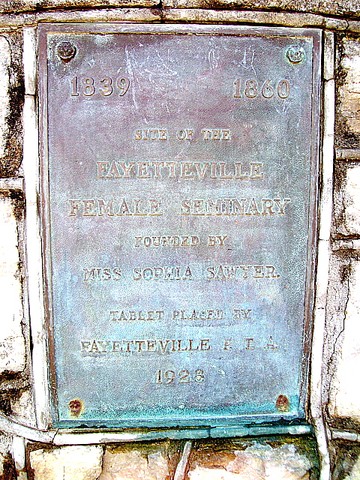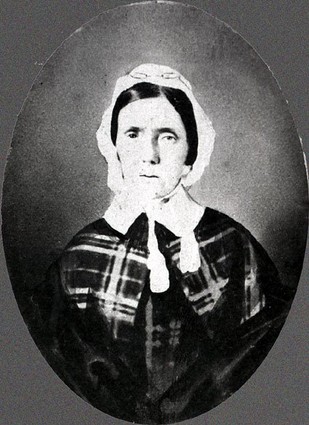Fayetteville Female Seminary (1839-1860)
Introduction
Text-to-speech Audio
Sophia Sawyer, a former missionary teacher among the Cherokee, founded the Fayetteville Female Seminary in 1839. The school originated with classes given by Sawyer to the children of Major Ridge, a Cherokee leader who was murdered by other Cherokee owing to his support of the Treaty of New Echota which led to the Trail of Tears. Sawyer also began teaching the children of prominent families which led to the donation of this land for the purpose of a school for women. By 1854, the school had over a hundred students but that year also saw the death of its founder. The school continued for another six years and was incorporated by the state but closed at the outbreak of the Civil War.
Images
This historical marker can be found on the north side of West Mountain Street near the intersection with Locust Ave

Sophia Sawyer circa 1850

Fayetteville Female Seminary circa 1852

Backstory and Context
Text-to-speech Audio
Sophia Sawyer began her educational work as a missionary to the Cherokee. She followed John Ridge from Georgia to present day Oklahoma. Here she established a school in John Ridge's house to teach Cherokee children. After John Ridge's assignation by rival Native Americans, Sawyer moved to Fayetteville, AR with Sarah Ridge. This move, while due in part to her loyalty to Sarah Ridge, took place because Sawyer feared for her safety because of her association with the Ridge family.
It did not take long after Sophia Sawyer founded the Fayetteville Female Seminary for it to become influential in the community. The school, in contrast to local norms, was open to both Cherokee and white students. Classed went for five week semesters and cost $8 per semester. The school had its own dormitory that the students could stay at if they choose or they could stay with local prominent families. The curriculum included Music, literature, French, and emboridery.
At the school's peak, over 100 students were enrolled. However, the Civil War caused the school to shut down. After the Battle of Prairie Grove, the school was used as a hospital and then burned by Confederate troops. The legacy of the school lived on, however. When the time came for Arkansas to determine the location of the state's land-grant university (which became the University of Arkansas), Fayetteville's reputation as a community that valued education, due in large part to the Female Seminary, was the determining factor in in the university being placed in Fayetteville.
It did not take long after Sophia Sawyer founded the Fayetteville Female Seminary for it to become influential in the community. The school, in contrast to local norms, was open to both Cherokee and white students. Classed went for five week semesters and cost $8 per semester. The school had its own dormitory that the students could stay at if they choose or they could stay with local prominent families. The curriculum included Music, literature, French, and emboridery.
At the school's peak, over 100 students were enrolled. However, the Civil War caused the school to shut down. After the Battle of Prairie Grove, the school was used as a hospital and then burned by Confederate troops. The legacy of the school lived on, however. When the time came for Arkansas to determine the location of the state's land-grant university (which became the University of Arkansas), Fayetteville's reputation as a community that valued education, due in large part to the Female Seminary, was the determining factor in in the university being placed in Fayetteville.
Sources
Castelow, Teri L. "Miss Sophia Sawyer: Founder of the Fayetteville Female Seminary." Arkansas Historical Quarterly, vol. 68, no. 2, 176-200. Published Summer 2009. https://www.jstor.org/stable/40543182.
